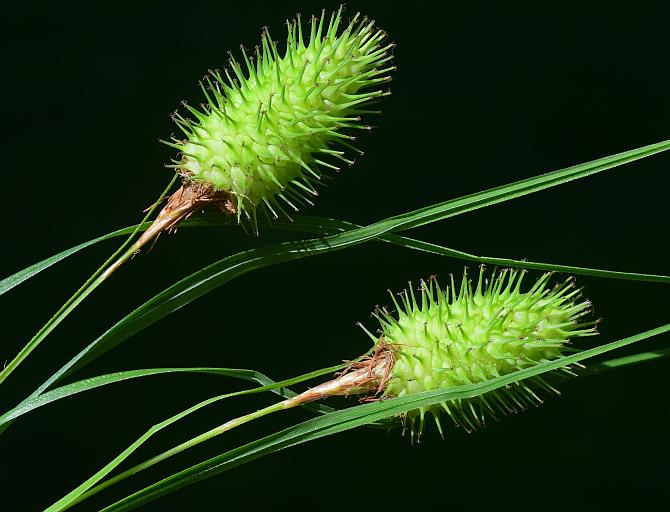Carex squarrosa L.

Native
CC = 6
CW = -3
MOC = 66
© SRTurner
Carex squarrosa L. | |
 |
Native CC = 6 CW = -3 MOC = 66 |
© SRTurner |
|
Family - Cyperaceae Habit - Monoecious perennial sedge with short rhizomes, forming clumps. Stems - Sharply trigonous, 15-80 cm long, brown at the base, glabrous.
Leaves - Leaf blades 2-40 cm long, 2-6 mm wide, flat with the margins usually curled under. Leaf sheaths with the tip usually extended slightly past the insertion point of the leaf, truncate to shallowly concave, the ligule longer than wide and V-shaped, the ventral side thin, papery, and white to light tan, the lowermost sheaths brown to nearly black.
Inflorescence - Inflorescence with 1-4 spikes loosely spaced near the tip of the axis, the lowermost bract lacking a sheath or nearly so. Spikes - Terminal spike pistillate toward the tip and conspicuously staminate toward the base, the pistillate portion 10-35 mm long, 15-25 mm wide, narrowly oblong-elliptic to narrowly ovate in outline, rounded at both ends, the staminate portion 9-18 mm long, linear to narrowly obtriangular. Lateral spikes (if present) 1-2, similar to the terminal one, but entirely pistillate or less commonly with a few staminate flowers at the base. Staminate scales 3-6 mm long, oblanceolate to narrowly lanceolate, the tip tapered to a sharp point, orangish brown with a green midrib and lighter margins. Pistillate scales 3-5 mm long, oblanceolate to lanceolate, the tip tapered to a sharp point or short awn, shorter than the perigynium and mostly obscured by it, orangish brown with a green midrib and lighter margins.
Perigynia - Perigynia 5-9 mm long, spreading widely to horizontal, the surface with 2 ribs, otherwise nerveless or with 5-9 faint nerves, yellowish green to light brown at maturity. Styles strongly curved or contorted near the base. Fruits with the main body 2.2-3.0 mm long, narrowly elliptic in outline, bluntly trigonous, dark brown to nearly black, often somewhat iridescent.
Flowering - April - September. Habitat - Swamps, bottomland forests, bottomland prairies, moist depressions of upland prairies, ponds margins, marshes, fens, railroads, roadsides, and ditches. Origin - Native to the U.S. Lookalikes - Other species of Carex. Other info. - This attractive sedge is found across most of Missouri except for the eastern Ozarks and the far northwestern corner of the state. Beyond Missouri it is found mainly in the Midwest and the northeastern U.S. Its large and conspicuous terminal spikes are often borne singly on the culms, and have a conspicuous staminate portion directly beneath the perigynia. The perigynia have long beaks but the pistillate scales are generally not visible. The species is found in wet places, sometimes in standing water. Photographs taken at Millstream Gardens Conservation Area, Madison County, MO, 5-24-2020, and Route 66 State Park, St. Louis County, MO, 6-13-2021 (SRTurner). |